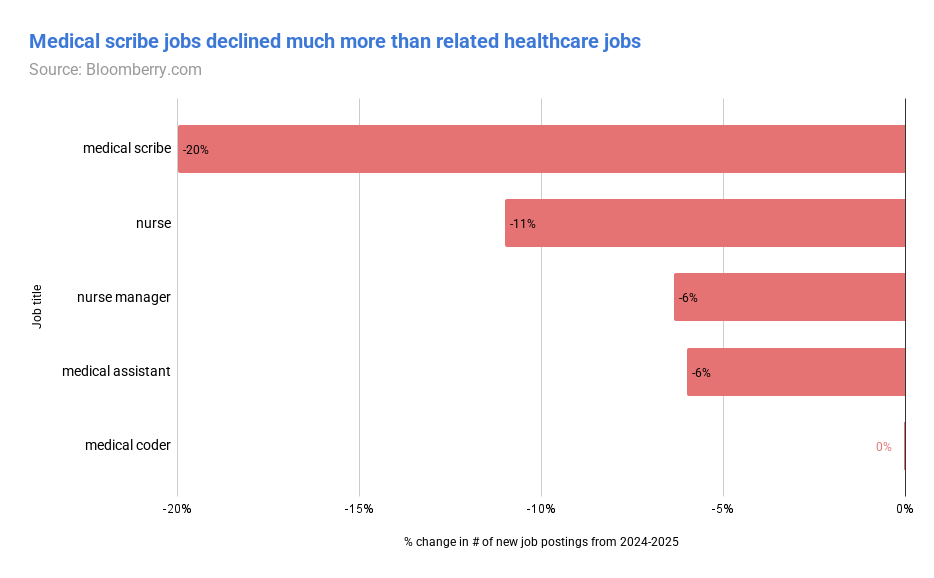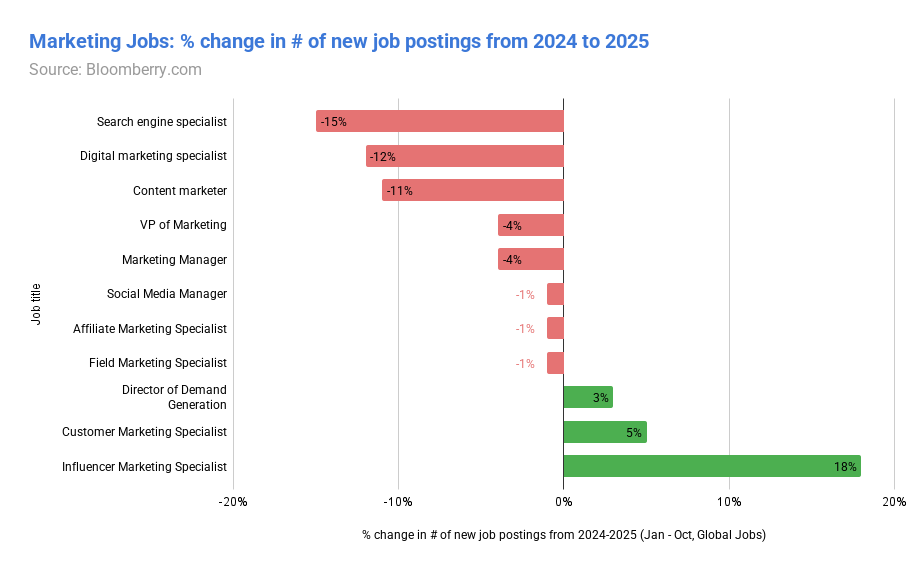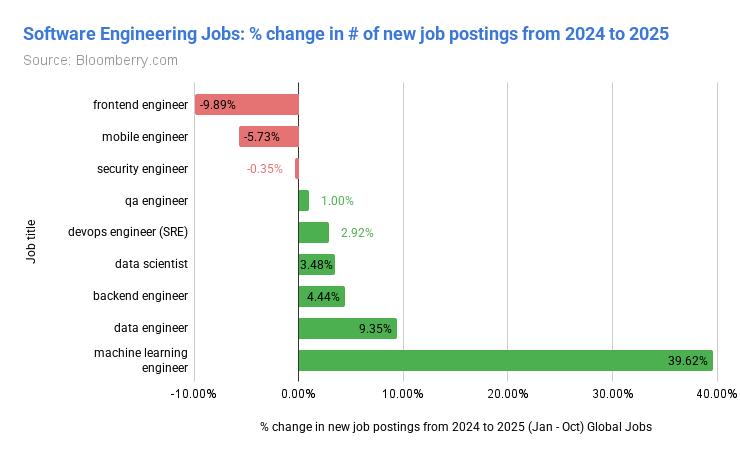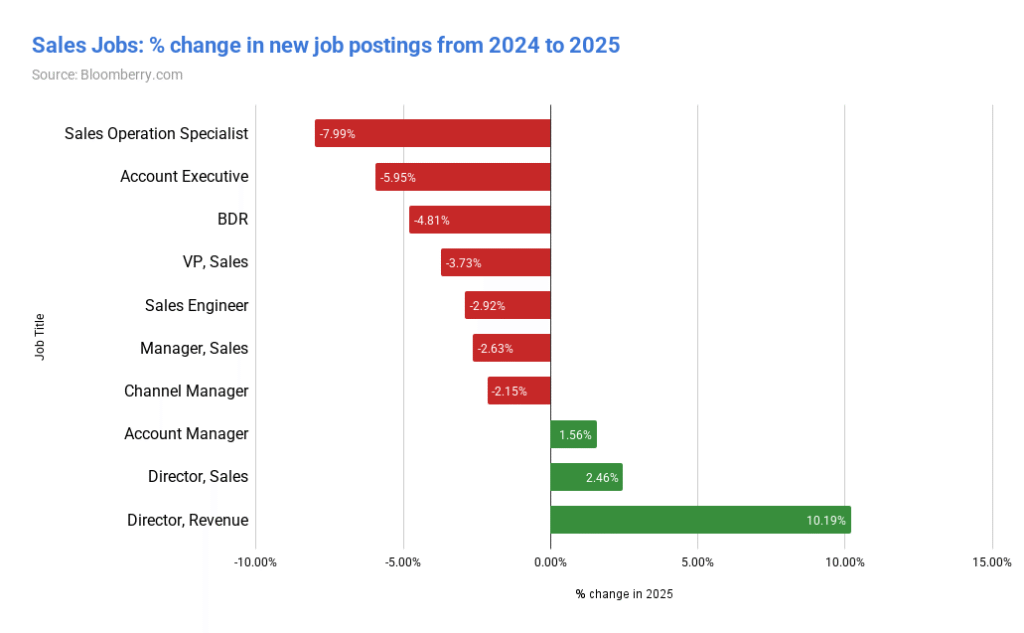Last Updated: November 14, 2025
What impact is AI having on the job market?
Everyone has an opinion, but there’s surprisingly little hard data.
Instead, what we have are very general studies that analyze broad sectors, and studies that just look at a specific segment like young workers.
So I decided to perform my own study. I analyzed nearly 180 million global job postings from January 2023 to October 2025, using data from Revealera, a provider of jobs data. While I acknowledge not all job postings result in a hire, and some are ‘ghost jobs’, since I was comparing the relative growth in job titles, this didn’t seem like a big issue to me.
I simply wanted to know which specific job titles declined or grew the most in 2025, compared to 2024. Because those were likely to be ones that AI is impacting the most.
For those that are busy, you can jump to a specific section of this study you’re interested in. The exact methodology I used is in the very bottom too.
- Total Job Postings declined 8% in 2025
- Which job titles declined the most in 2025 compared to 2024?
- Creative jobs declined the most but not all of them
- Corporate compliance + sustainability jobs are declining fast
- AI might be taking away jobs from medical scribes
- Which job titles increased the most in 2025 compared to 2024?
- Machine Learning Engineers were the #1 growing job in 2025
- Demand for senior leadership is much stronger than middle managers
- Influencer marketer was 1 of the top growing jobs overall in 2025
- Software Engineering Jobs have been resilient in 2025
- Data-related jobs are holding steady
- Customer Service Representatives jobs are not being mass replaced by AI
- Sales jobs are holding steady
- My Methodology
- Want to know how your job title performed in 2025?
1. Total Job Postings declined 8% in 2025
First, let’s establish our benchmark: job postings dropped 8% in 2025 compared to the same period in 2024. Indeed reported a 7.3% year-over-year decline for US jobs recently, so this was a good sanity check, and told me that my data most likely was comprehensive.
Why does this 8% number matter? Because it’s our baseline. When we look at individual job titles and their % change, we need to know: are they following the market down, or are they getting hit harder?
Could AI be partly responsible for this overall 8% decline? Maybe – but that’s nearly impossible to separate from macro factors. So this analysis focuses on jobs with dramatic deviations from the market trend, where AI’s impact is most clear.
Jobs with the Biggest Declines in 2025
Now, let’s start with the jobs with the biggest declines year over year:

2. Creative roles that “execute” are declining while creative leadership roles are doing OK
Among the top 10 declining roles, 3 are creative positions: computer graphic artists (-33%), photographers (-28%), and writers (-28%). Computer graphic artists includes roles such as technical artists, 3d artists, and VFX artists. Writers include copywriters, copy editors and technical writers.
Just outside the top 10, journalists/reporters (-22%) is also experiencing a decline. PR specialist jobs also declined -21%.
This isn’t a one-year blip, unfortunately. These appear to be 2 year declines. Computer graphic artists have fallen for two straight years (down 12% in 2024, then another 33% in 2025). Photographers and writers followed the same pattern.
Looking beyond these declining roles, though, not all creative positions are suffering that much, relative to our -8% benchmark:

Roles that involve creative direction/strategy are much more resistant to AI. So jobs like creative directors, creative managers and creative producers are doing better than execution-roles.
Likewise roles that involve more complex decision making and client interactions are doing better. A graphic designer spends a lot of time interpreting client feedback, and iterating. The same goes for product designers. Their work involves conducting user research, and making strategic decisions about what to build and why.
So the theme here is not “creative jobs” are declining – it’s creative execution jobs are declining while strategic creative leadership jobs are doing OK.
3. Corporate compliance and sustainability jobs are declining
At least 3 of the top 10 declining roles have nothing to do with AI. They’re all regulatory and environmental positions: corporate compliance specialists (-29%), sustainability specialists (-28%), and environmental technicians (-26%).
These declines are even steeper than the creative roles, and they’re accelerating. Corporate compliance specialists dropped 6% in 2024, then 29% in 2025.
And this isn’t just hitting individual contributors. The collapse is happening across the entire hierarchy:
Sustainability roles:
- Sustainability specialists: -25%
- Project managers (sustainability): -32%
- Managers, sustainability: -35%
- Directors, sustainability: -31%
Compliance roles:
- Corporate compliance specialists: -28%
- Chief compliance officers: -37%
What’s happening here? If you live in the US, you probably know what’s happening. Sustainability specialists mostly help companies meet environmental regulations and ESG commitments, both of which became targets this year. Corporate compliance specialists ensure companies follow regulations, but if the government isn’t enforcing them, or even getting rid of some, why pay for compliance staff?
On the opposite side of the coin, trade compliance specialists grew 18% in 2025 (the reason being fairly obvious if you’ve been following tariff news).
4. AI might be taking away jobs from medical scribes but it’s too early to tell

Jobs for medical scribes dropped down 20% in 2025.
If we compare scribes to similar healthcare admin roles, we don’t see a similar drop. Medical coders? Basically flat at -0.02%. Medical assistants? Down just 6%, slightly better than the overall market. But scribes are declining at 20%.
The obvious culprit might be AI documentation tools which can now listen to patient conversations and automatically generate clinical notes. Medical scribes do valuable work, but it’s the kind of structured documentation task that AI has gotten better at.
That said, the picture isn’t very crystal clear. That’s because medical scribe jobs just dropped 2% from 2023 to 2024 before this year’s drop. So the cautious side of me says we need one or two more years of data before we know if this is a long-term decline. We’ll put medical scribes on the watchlist for now.
Now, let’s move on to the jobs with the biggest % increases..

5. Machine Learning Engineers were the #1 growing job
1 job title is absolutely exploding: machine learning engineers saw postings surge 40% from 2024 to 2025 – the single biggest increase of any role. That’s on top of a 78% increase in 2024.
And it’s not just ML engineers. The entire AI infrastructure stack is booming

- Robotics engineers: +11% (AI moving from screens into the physical world)
- Research/applied scientists in tech: +11% (companies building proprietary models, not just using OpenAI’s API)
- Data center engineers: +9% (all that AI inference needs massive compute infrastructure)
Companies need researchers to develop models, ML engineers to deploy them, robotics engineers to put them in warehouses and factories, and data center engineers to power the whole operation.
6. Demand for senior leadership is much stronger than middle managers + individual contributors
Here’s the most perverse finding in my data: while the overall job market contracted 8%, senior leadership roles barely declined at all.
Combining Directors, VPs, and C-Suite into ‘Senior Leadership’:

- Senior Leadership: -1.7% (beating the market by 6.3 percentage points)
- Manager roles: -5.7% (beating the market by 2.3 percentage points, but still worse than leadership)
- Individual contributor roles -9%
That’s a 4 percentage point gap between leadership and management. Both are doing better than average, but the higher you go, the better you’re doing.
Among the top 10 fastest-growing job titles, five are director-level or above:
- Director, Data Engineering: +23%
- Director, Real Estate: +21%
- Director, Legal: +21%
- Director, Software Engineering: +14%
- VP, Engineering: +12%
What’s happening? It might be that companies are adding strategic leadership while being more selective about operational management. They want more people deciding what to do, fewer people managing how it gets done, and even fewer people to execute on it. Google is a prime example of this, getting rid of most of their middle managers in the past year.
Part of this is AI-enabled. For instance, a director or VP can now use AI coding tools to quickly prototype ideas without needing a team of engineers. The same AI tools that threaten individual contributors are actually empowering senior leadership to operate more independently. A VP of Product who can spin up a working prototype in Cursor or validate a technical approach with Claude doesn’t need as many ICs reporting to them.
7. Influencer marketer was 1 of the few growing marketing jobs
Marketing jobs, as a whole were fairly resilient. Most hovered around the benchmark. But 1 marketing role stood out: influencer marketing specialist roles jumped 18.3% from last year. This isn’t a 1 year blip as well. Influence marketer jobs increased 10% last year, so this is a 2-year pattern.

The best explanation? Influencer marketing has gotten really good at proving its worth with sophisticated tracking, attribution modeling, and actual ROI measurement. Brands can see exactly which creator partnerships are driving sales.
But there’s a bigger trend happening, in my opinion, and it’s related to AI. As people flood the internet with AI content, traditional channels are losing what little trust they had left. Search results? Increasingly AI-generated slop. Display ads? Always annoying, now potentially AI-designed. Cold emails? Obviously AI-written and sprayed to a bunch of random strangers. People are developing an immune response to everything in the internet. But a skincare video from a TikTok creator their age? That still feels real and genuine.
I asked 2 of the brightest minds in marketing what they thought of this, and this is what they had to say:
“Trust in businesses and advertising continues to erode, but we trust each other — our friends and family members. Influencers are not just young people shilling products. They are viewed as trusted online friends, and that is a powerful voice for brands to connect to and leverage” says Mark Schaefer, Executive Director of Schaefer Marketing Solutions.
I asked Rand Fishkin, founder of Sparktoro to chime in with his thoughts, and he acknowledges how influencer marketing has remain one of the few bright spots left in digital marketing:
“Digital marketing jobs have been in a tough spot for a couple years now, with SEO, content, and social being particularly hard hit thanks to the rise of Zero Click Everything (i.e. search engines and social networks substantially curtailing the amount of traffic they send out). One of the few bright spots in all of this has been the rise of Zero Click Marketing (aka influencing people where they pay attention without necessarily trying to draw direct traffic). Little wonder that creator/influencer marketing specialists are one of the few categories that embrace this and are still growing.”
Lastly, let’s look at what jobs have been the most resilient:
8. Software Engineering Jobs have been resilient in 2025
While there’s been a lot of talk about AI replacing software engineers, the data has suggested the opposite: the # of software engineering jobs have not changed much since last year.

Most engineering roles are either growing or hovering near the benchmark. This is happening in a year where GitHub Copilot, OpenAI Codex, Claude Code, and a dozen other AI coding assistants are supposedly making human programmers obsolete.
The obvious explanation is that AI tools are making engineers more productive, not redundant. When you give a developer Copilot, they don’t become unnecessary – they ship features faster, tackle more complex problems, and spend less time on boilerplate code.
One interesting data point is that frontend engineering jobs have declined the most out of any software engineering job. I can’t help but wonder if it’s because of the influx of vibe coding tools like Replit, Lovable and Bolt.new that have made it super easy to create a front-end for a website or app. I doubt AI is getting rid of sophisticated frontend work (like building a frontend app like Figma), but perhaps it’s having an impact on the less complicated work.
Still, despite all the hype about how AI coding tools will replace software engineers, software engineering is still one of the most secure jobs you can have today, relative to most other white-collar jobs.
9. Data-related jobs are holding steady despite AI tools
With AI making it easier than ever to analyze data, you’d expect data analyst jobs to be declining. Jobs for data engineers and data scientists have grown steadily over the past few years, but what about data analysts?
- Data Analyst: +0.5%
- Data Management Specialist: +1.1%
Both roles are outperforming the overall market, suggesting that AI tools for data analysis aren’t replacing data analysts – at least not yet.
This mirrors what we saw with software engineers. AI tools like ChatGPT can write SQL queries and create visualizations, but they’re making analysts more productive rather than redundant. When you give an analyst AI assistance, they don’t become obsolete – they tackle more complex questions, spend less time on routine queries, and deliver insights faster.
The data analyst role still requires understanding what questions to ask, knowing which data is trustworthy, and translating findings into business recommendations.
10. Customer Service Representatives jobs are not being mass replaced by AI as of now
If there’s one job everyone assumed AI would eliminate, it’s customer service representatives. Yet customer service rep jobs are declining just 4.0% – beating the -8% benchmark despite companies trying to automate customer service with AI.
I’m sure we’ve all heard the stories of companies that make a big deal of implementing AI chatbots and laying off their customer service team. Klarna made headlines by replacing their customer service team with AI, only to hire them back.
Many companies discover chatbots handle simple queries fine but completely fail on anything requiring judgment or empathy. When customers are angry or confused, they want a person who understands their frustration, not a bot going through a script. Good customer service involves empathy and making occasional judgment calls such as waiving fees or issuing a refund.
Plus, I’m sure a lot of companies don’t want the bad press associated when an AI chatbot promises the wrong thing to a customer.
11. Sales Jobs Are Holding Steady, But There’s No Clear Pattern
Sales roles, as a whole, are performing better than the overall market benchmark of -8%. Most sales positions declined only slightly, or even growing:

But unlike other categories where we saw clear patterns – like creative execution roles declining while creative leadership held steady – sales jobs don’t follow an obvious hierarchy. It’s a mixed bag at every level.
Individual contributors? Account executives are down -5.9%, but account managers are up +1.6%. Middle management? Sales managers are down -2.6%, but directors of sales are up +2.5%.
Why is Director of Revenue the fastest-growing sales role?
The 10.2% jump in Director of Revenue roles stands out as the only sales position showing significant growth. This role is relatively new – it didn’t really exist a decade ago – and represents a shift in how companies think about growth.
Why the surge now? A few theories:
First, companies are getting more sophisticated about revenue operations. In a tighter economy, you can’t just throw more salespeople at the problem – you need someone optimizing the entire system. Director of Revenue roles often own the data infrastructure, compensation models, territory planning, and tech stack that makes everyone else more efficient.
Second, the rise of product-led growth means revenue doesn’t stop at the initial sale. You need someone thinking about expansion, upsells, retention, and churn – not just new logos. Director of Revenue is the person who owns that holistic view.
The one role that declined the most?
Sales operations specialists at -8.0% – basically matching the overall market. These roles focus on CRM management, analytics, and process optimization. It’s possible AI tools are handling more of this structured, data-heavy work, but with just one year of significant decline, it’s too early to call it a trend.
What about GTM Engineers?
If you talk to people in the sales world, you’ll hear a lot of buzz about “GTM engineers” – technical specialists who use AI tools like Clay to build sophisticated prospecting systems, automate outreach, and optimize the entire go-to-market stack. These roles didn’t make our threshold due to low job volumes, but if they did, they would’ve been the fastest growing sales-related job, as they grew 205% year-over-year.
Conclusion
So what should we take away from all this? First, AI isn’t causing huge spikes in unemployment – most jobs in our analysis did not drastically plummet. But it’s insincere to say AI is having zero impact either. It’s impact is selective. It’s hitting some creative work hard, while roles requiring empathy, strategy, or complex problem-solving such as software engineering, creative directors, and customer service remain surprisingly resilient.
Computers graphics artists, writers and photographers could be in secular decline. 2 years is not a lot of data, mind you, but I think the trend so far isn’t very encouraging. However, other creative jobs like graphics designers, product designers and creative directors haven’t decreased that much in demand so far.
Lastly, we’re seeing bifurcation everywhere. Creative work is splitting between strategic roles (holding steady) and execution roles (declining). Marketing is dividing between traditional marketing jobs (shrinking) and influencer marketing jobs(growing). Senior leadership jobs are holding steady, middle managers a bit worse, while individual contributor jobs are the worst performing. Even within tech, backend complexity is valued while frontend work becomes a tad more commoditized.
It’ll be interesting to see if these trends hold beyond 2025 into 2026.
Exact Methodology (the technical details)
I developed a taxonomy of 650 distinct, normalized job titles (graphics designer, nurse, etc) and used Amazon Mechanical Turk workers to label millions of random job postings taken from Revealera (a data provider for job postings for financial companies). From this training data, I built a machine learning model that classified all 180 million postings into normalized job titles.
These job postings were global job postings – not just US-centric, and included a variety of companies: large enterprises, SMBs, medium-sized companies, startups, government organizations, and universities, from all types of industries. They were taken directly from company websites, not from an aggregator like Indeed/Linkedin, so there were very few duplicates.
With this dataset, I could identify which specific job titles grew or declined the most in 2025 (January-October) compared to 2024 and 2023 – and theorize whether AI might be a factor.
For those who are into machine learning:
I built a supervised learning pipeline for job title classification using semantic embeddings and ensemble methods.
Architecture:
- Sentence Transformer Fine-tuning: Uses contrastive learning to fine-tune a sentence transformer model (default:
all-mpnet-base-v2) on job description pairs – positive pairs (same job title) and negative pairs (different titles) - Embedding Generation: Generates dense vector representations of job descriptions using the fine-tuned transformer
- Multi-class Classification: Trains a Random Forest classifier on top of the embeddings to predict job titles
Want to know how your job title performed (and it’s not in this study)?
Leave a comment on my Linkedin post and I’ll try to look up the data and answer it for you.




